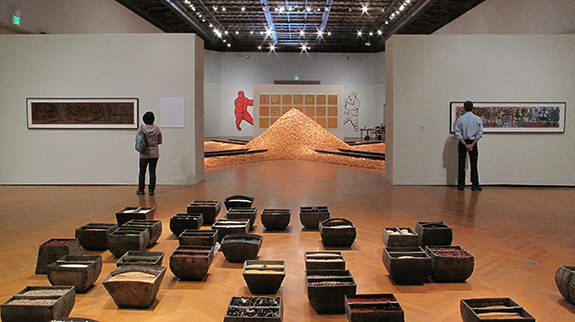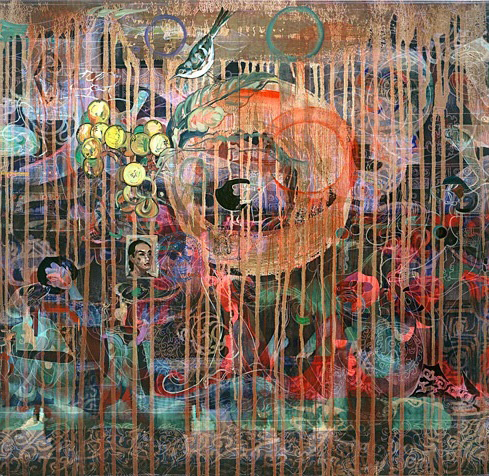by David M. Roth
 |
If memory is the subject and subtext of much art, why do so few artists address the one sensory mechanism most capable of unlocking it? The practical answer is that olfactory sensations can’t be readily contained or captured. Yet smell, as everyone knows, is a potent memory trigger.
Hung Liu makes full use of it. For the installation portion of her 40-year retrospective (Hung Liu: Offerings) that runs through March 17 at Mills College Art Museum and continues with Summoning Ghosts: the Art of Hung Liu at the Oakland Museum of California starting March 16, she displayed 34 antique vessels (dous) filled with traditional Chinese foodstuffs: dried mushrooms, grains and legumes. Titled Tai Cang — Great Granary, it filled the room with a musky scent redolent of green tea that, for those susceptible to such inducements, must have worked like a memory stimulant – at least while the contents were fresh. It is one of two installations sharing floor space in this elegant, coffered-ceiling space. The other consists of four intersecting train tracks topped by a mound of 200,000 fortune cookies called Old Gold Mountain – a tribute to the Chinese laborers who built the Transcontinental Railroad and who referred to San Francisco by that name.
 |
Displayed alongside paintings, drawings and sculptures, they add up to a tour-de-force prelude to the upcoming OMCA show which promises to bring into even sharper focus the qualities that have made Liu one of the Bay Area’s most admired artists — and one of the world’s most effective history painters. Prominent among those qualities are her skills as a realist, her riveting site-specific installations, and the abstract-painting techniques she applies to figuration and landscape.
 |
 |
Significantly, the confections displayed in this installation contain no fortunes. Brittle and empty, they mirror the broken dreams of Chinese who came to California seeking riches that flowed mostly to others. The golden cookie pile also references an old Manchurian custom: the burial mound. It’s an apt allusion to the hard labor, racial discrimination and ghetto living conditions that were then and still are the reality of California’s Chinatowns.